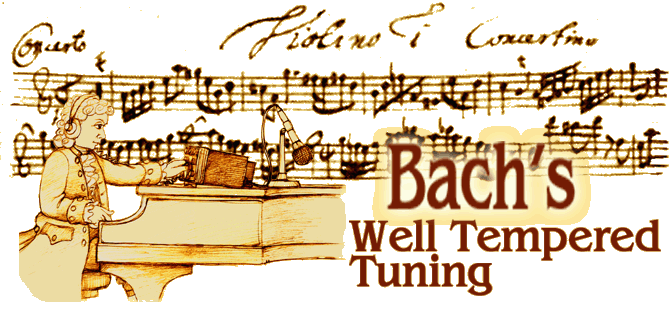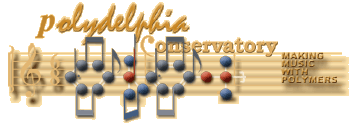There are not only polymers in a piano, but also in the tuning, care and repair of a piano as well. Most of the parts inside a piano are made of polymers, whether natural or synthetic, and the piano technician is responsible for replacing and repairing all of these parts.
 This lever, used for moving the tuning pins
This lever, used for moving the tuning pins
to change the pitch of a note, has a wooden
handle and a foam grip.
|
The piano technician also has a vast array of tools, glues, lubricants and solvents which are - in part - polymers. Though most of the tools used to adjust the tuning and movement in a piano are metal, the tuner still needs the aid of muting devices which are made of rubber or wool felt. And, of course, many of the tools have wooden or plastic handles. This tuning lever has a wooden handle with a special soft grip made of a polyurethane foam.
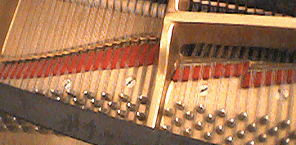
 The pin block hides under the cast iron plate
The pin block hides under the cast iron plate
and the pins stick up through it to hold the
strings
|
The tuning lever is used to turn the tuning pins, which are large metal pins that hold the piano strings tight. The pins sit tightly in a wooden (cellulose) pin block which is made of hardwood such as maple. Sometimes that pin block is formed from laminated layers of wood, which makes it strong and resistant to splitting.
Though the pins fit very tightly into the wooden block, the iron piano plate sits atop the pin block and gives added support to the tuning pins which are under a great deal of tension (about 1000 pounds per string). Most notes in a piano consist of more than one string in order to give the sound more volume. When tuning one string it is neccessary to keep the other strings in the note quiet so as not to get confused. This is where mutes come in.
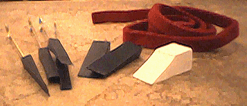 These felt and rubber mutes are used to
These felt and rubber mutes are used to
deaden strings so the technician can hear
the one he wants to tune.
|
These are rubber mutes used on grand piano strings. And that's the same black SBS rubber that's used in car tires. And the felt temperament strip can be used to mute whole sections of strings in a grand or an upright piano. The thick red felt is made from wool, a natural polymer.
Besides keeping the piano in tune, the technician must make sure that everything is working smoothly. The action is made up of thousands of tiny moving parts. Most of them are held in place with metal pins with felt bushings. When these get too tight to move they can be lubricated with a silicone oil mixture, while other moving parts may be lubricated with a dry teflon powder.
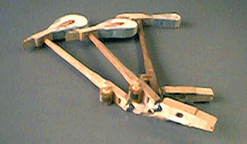 The leather "knuckles" on the undersides
The leather "knuckles" on the undersides
of the grand piano hammers are often dusted
with teflon to make the letoff of the
action smoother.
|
Another thing that the technician does is voicing the piano. This is the process of changing the tone of the piano to sound bright or soft. This is done by changing the hardness of the piano hammers. To make the sound softer the hammers must be softened with a needle tool, but to make the tone brighter the hammers must be hardened on the ends. This is usually done by adding a little drop of laquor to harden the end of the hammer felt.
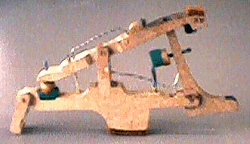 This grand whippen assembly includes quite
This grand whippen assembly includes quite
a few brass center pins in the moving parts.
These pins may be lubricated with a special
silicone oil.
|
The laquor is some kind of polymer, like nitrous cellulose or polyester. Our piano technician here at USM dissolves leftover plastic piano keytops in acetone and uses this mixture as a hardener for hammers, but this process must be done with great care, usually just a drop at a time.
A technician must also use polymers in replacement and restoration of parts. One of the first things to get worn on a piano is the felts. When hammer felts are worn down they can be sanded back into shape a few times before the hammer must be replaced. Other felts simply get old and frayed. Some of the most important felts are the key bushings. These are inside the piano keys and serve to help the keys move smoothly and silently up and down. When new felts are glued in, hide glue is used. This sticky glue is made of horse hide is also used to glue most wooden parts together, For instance when new hammers are glued onto the wood shanks.
All this stuff is a mere fraction of what a piano technician may have to do to maintain a piano. And, as you can see, much more goes into the care of a piano than simply tuning it.

